Various parts of sea buckthorn plant are rich in protein. Approximately 15% protein are found in sea buckthorn leaves, that’s why they are used as an unconventional source of protein in human food.
Distribution of protein in sea buckthorn berry varies widely in particular parts, the sea buckthorn seeds being considered a unique protein source. In Mongolian wild sea buckthorn species, approximately 38% of total protein was found in seeds.
 Comparing to other berry varieties, sea buckthorn berries are characterized by a relatively high content of protein. Additionally, the protein levels in sea buckthorn juice are quite high for a fruit juice and this is why sea buckthorn juice is a cloudy or opalescent product. The source of opalescence in most juices is due to the presence of cellular debris, but mainly due to the presence of cell membranes that contain considerable proteins and give a stable turbidity to the juice. The total protein content in various species of sea buckthorn were 46–129 g/kg dry weight.
Comparing to other berry varieties, sea buckthorn berries are characterized by a relatively high content of protein. Additionally, the protein levels in sea buckthorn juice are quite high for a fruit juice and this is why sea buckthorn juice is a cloudy or opalescent product. The source of opalescence in most juices is due to the presence of cellular debris, but mainly due to the presence of cell membranes that contain considerable proteins and give a stable turbidity to the juice. The total protein content in various species of sea buckthorn were 46–129 g/kg dry weight.
Sea buckthorn juice is rich in many free amino acids. A total of 18 of the 22 known amino acids have been found in sea buckthorn fruits, half of which are essential because they play a critical role in various processes in the human body. Of these, eight free amino acids (threonine, phenylalanine, methionine, leucine, lysine, tryptophan, isoleucine, and valine ) are essential for the human body. Leucine and lysine in sea buckthorn are deficient in the majority of other plant feedstuffs. Methionine and cysteine were observed as the limiting amino acids.
Aspartic acid was reported as the predominant free amino acid in sea buckthorn berries (426.6 mg/100 g), followed by proline (45.2 mg/100 g), and threonine (36.8 mg/100 g), while a different hierarchy was also found in terms of quantity, the dominant amino acid in sea buckthorn being asparagine, followed by glutamic acid and alanine. Asparagine was also found quantitatively predominant in sea buckthorn in other more recent studies. Since the full range of proteinogenic amino acids and essential amino acid content in sea buckthorn is high, it is within a class of relatively high-quality plant protein resources.

Leave A Comment